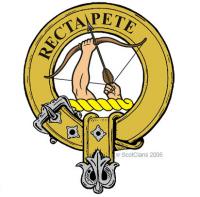
Clan Fletcher
The name Fletcher is fairly widespread across Scotland, the reason being that it comes from the gaelic 'Mac-an-Leister', meaning 'son of the arrow-maker'. The arrow makers would associate themselves with various clans for whom they would make arrows.
For example, the Stewarts and Campbells in Argyll, and the MacGregors in Perthshire (the Fletchers of Glenloyn were associated with the MacGregors).
The Fletchers claim descent from Kenneth MacAlpine, a ninth century king, their badge being the Royal Pine Tree. The oldest recorded clan chief was Angus Mac-an-leister, born c. 1450 The Perthshire Fletchers lived at Glenorchy, even after the MacGregors had been forced out of the area in 1442. They eventually lost the land to Duncan Campbell during the reign of James VI, but stayed in the area as tenants.
One of the Fletchers who followed the MacGregors is on record as having saved the life of Rob Roy during a conflict, when he was disabled by a dragoon.
The Clan took part in the first Jacobite rebellion, under leadership of the ninth chief, Archibald Mac-an-leister. During the second Uprising of 1745, the clan fought on both sides, thus avoiding forfeiture.
The majority of the clan were evicted from Glenorchy (during the Clearances) by the Campbell Marquesses of Breadalbane, many of them emigrating to the United States and Canada.
The Fletchers of Saltoun and Innerpeffer (in Angus), allegedly descendants of Sir Bernard Fletcher of York, purchased the Estate of Saltoun in Haddington in 1643.
In 1653 the well-known Scottish patriot and politician Andrew Fletcher was born here. As a member of the Scottish Parliament he campaigned for the rights of the Scottish People and famously opposed the Act of the Union in 1707.
Dunans Castle is the original home of the Fletcher Clan. Although the site has been settled since 1590, the Fletchers arrived in 1764, bringing with them the door of their previous home, Allachader Castle. The Castle was sold and passed out of ownership by the clan in 1997.
The fourteenth Chief of the clan died in 1911, in New York, leaving no direct heirs.








